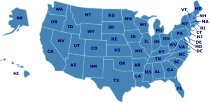Map & Globe Skills
The ability to properly read maps and globes gives you an opportunity to explore different places, people, and cultures in the real world. These resources, teaching tips, and ideas will help make it easy for your children to learn to read and understand maps and globes.
Activities & Experiments
Postcard Kids
Geography Postcard Kids Project started for homeschooled children around the world in October of 2002. It is intended to help enhance geographic studies by sending postcards from their local area to other postcard kids around the world.
Great States Board Game
What is the capital of NJ? Where is the Football Hall of Fame? These are just a few of the hundreds of questions players are asked as they adventure around the USA discovering state attractions and landmarks, capitals, state abbreviations, state locations and more. In order to answer the questions on the cards, players must look closely at the colorful USA map game board, becoming familiar with the geography of the country. Players must hurry to find the answers as the mechanical timer ticks. Contents: Game board, 100 Figure cards, 100 Fact cards, 100 Find cards, 1 spinner, 1 mechanical timer, and game rules. Duration of Play: 20 minutes. 2-6 players.
Name That Country Game
"Dear Pen Pal, Konnichi wa! We've been to see Mt. Fuji. Name my country! Sayonara, Michiko." Challenge your group with this fast-paced geography game, created in 1992 by Educational Insights, Inc. Everyone begins at the post office. Players twirl a finely printed spinner (built into the game board itself) to select one of 60 countries. If the player can correctly identify the country's location on the board's numbered map, he or she may advance along the path to the finish. Bonus moves are won by landing on "postcard" spaces, listening to the clues on one of the 40 postcards, and correctly identifying the pen pal's country. (The sample postcard above came from Japan.) A more challenging game can be achieved by requiring players to name the country's capital; answers are provided. --Liane Thomas
Teaching Tips & Ideas
Knowledge Quest
Knowledge Quest offers historical outline maps and timelines designed for the interactive study of world history and geography.
How I Teach a Large Family in a Relaxed, Classical Way: History
A look at teaching history across several grades using the classical method of education and a rotation of history every four years.
Featured Resources
As an Amazon Associate, we earn from qualifying purchases. We get commissions for purchases made through links on this site.
Don't Waste Your Time Homeschooling: 72 Things I Wish I'd Known
Traci Matt, a veteran homeschool mom helps you make the most of your homeschooling efforts. She takes a look back at 20 years of successes and challenges, offering tested strategies to assist you on your home education journey. This book will help you learn ways to keep a peaceful home, stay out of the isolation trap, practice self-care, learn how to live with teens, and respond to the questions of others.
Homeschooling: The Early Years: Your Complete Guide to Successfully Homeschooling the 3- to 8- Year-Old Child
Nothing beats seeking the voice of experience if you want to join the estimated 1 to 3 million parents who teach their children at home. Here's a guide that comes direct from the experts: a mother of two homeschooled, now-grown children and 83 homeschooling families she surveyed. Their stories make reading this starter kit on teaching ages 3 to 7 worthwhile. For those ready to take on what author Linda Dobson calls "a natural extension of being a good parent," the manual provides at-a-glance box...
Educational Travel on a Shoestring : Frugal Family Fun and Learning Away from Home
Educational Travel on a Shoestring shows parents how they can help their children learn–and have a blast–while traveling. From researching destinations to sharing activities that both teach and entertain, this priceless guide offers practical information for parents who want to have more fun with their kids, build closer family ties, and enjoy richer educational experiences–all without spending a fortune.
Critical Thinking: Reading, Thinking, and Reasoning Skills
Based on Bloom's Taxonomy of Educational Objectives, Critical Thinking will allow students to garner more knowledge from new information by knowing, applying, analyzing, synthesizing, and evaluating. A brief review in each unit provides frequent indications of student mastery. This series is written for grade levels 1-6.
Real-Life Homeschooling: The Stories of 21 Families Who Teach Their Children at Home
The book that shows homeschooling in action! What does it really mean when parents say they homeschool their child or children? For Rhonda Barfield -- a homeschooler for the past 10 years -- the definition is as diverse as the 21 families she studies in this eye-opening book. Real-Life Homeschooling From the city to the country, apartments to split-levels, you'll enter each household and see education in action. Discover the challenges and rewards of tailoring instruction to each child's nee...






